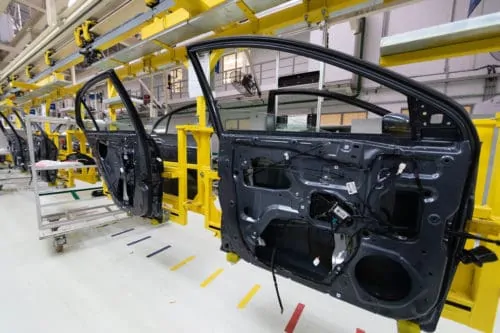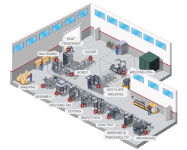The Current State of Automotive Automation
Today, the automotive industry is looking for ways to increase manufacturing flexibility, enhance efficiency, and meet growing demands. Incorporating automation into the automotive manufacturing process streamlines production and logistical systems, while allowing for quick market adaptation to meet the demand for newer, smarter vehicles and accessories.
The flexibility of automation allows manufacturers to make design and manufacturing changes simply by reprogramming the system in place, eliminating the need to scrap entire production lines when demands change. This flexibility allows for fast and easy acclimation to changing market conditions and requirements, granting automotive manufacturers with a competitive edge.
Car assembly plants typically use automation for processes such as painting and spot welding, but many other areas of the supply chain can benefit from it. Tier 1s, OEMs, and other parts producers can all gain advantages from automation, including:
- Increases competitiveness
- Improves quality
- Reduces warranty costs
- Increases capacity
- Decreases risk of bottlenecks
- Protects workers from dangerous, difficult, and dirty jobs
Automotive Applications for Automation
It takes a multitude of manufacturing processes to make the thousands of parts needed for cars and trucks. Advances in automation technology such as force sensing and vision systems means that more of these processes are suitable for automation.
Some of the best-suited automotive applications include:
Automation is suitable for both spot and arc welding. Larger robots with long reach capabilities and high payload capacities can spot weld vehicle body panels, while smaller robots can weld subassemblies such as mounts and brackets. Not only can automated welding units be configured to handle multiple types of welds, but they can also easily follow repetitive instructions for hundreds or thousands of production cycles per day without deviating from the specifications.
Robotic arms are capable of handling assembly tasks such as wheel mounting, windshield installation, and screw driving. Automation can also be used to assemble smaller part assemblies such as motors and pumps.
Automated Assembly and Testing of Auto Parts
When you look at a car, there are thousands of parts that make up the vehicle than what meets the eye. For example, cars have upwards of 30,000 components. Every part has its importance to the overall vehicle and manufacturers need to ensure they are of the highest quality. This is no easy feat, as the operation of these individual parts requires meeting stringent standards and the use of high-precision machines to perform consistently.
AMD can help because we have performed an abundance of auto part assemblies and testing with all T1, T2, and T3 components. Everything from shock absorbers on the suspension to the seat headrest needs to be assembled and tested before it reaches the final assembly.
We have made testing stations for straightforward applications like a camera to detect the presence of the parts in an assembly or the mechanical resistance of a weld. We also have executed unique applications like differentiating headrests covered with real leather from synthetic leather even when the color is the same. The actual comparison is quite difficult to differentiate by the human eye.
We have made test stations to detect “noise” without a specific sound frequency or amplitude, the force needed to operate a button, synchronization of two small compartment doors on a central console, etc. We have also constructed many test stations to make functional tests on different mechanisms or electronic boards.
No matter the vehicle, no matter the part. We can perform any assembly operation or test for any manufacturer.
Automotive Automation with AMD
AMD specializes in global launches of automation systems for automotive plants. Our team handles the execution, launch, and support of both small and large automation projects. We have the capabilities to design and implement small-scale automation turnkey systems with low production to large, high-volume systems that manage complex tasks such as powertrains, electric vehicles, car interiors, and more.
For nearly 24 years, we have provided assembly systems and test equipment to automotive manufacturers that want to stay ahead of the curve. We provide complete turnkey services, including planning, designing, constructing, installing, and testing unique automation systems that serve each of our customers’ needs. We also provide after-sales services, including training and support. We have created thousands of systems that fulfill these production needs:
- Air Conditioning System Components
- Air Intake Filtering Systems
- Braking System Components
- Central Console Assembly
- Door Hinge Assembly
- Electric Power System Components
- Electronic Control Modules
- Exhaust System Components
- Fluid Pumps
- Fuel System Components
- Head Rest Testing and Assembly
- Lighting Systems
- Seat Mechanisms
- Shock Absorbers
- Window Mechanisms
- Wiper Control Components
Contact AMD for Automotive Automation Solutions Today
Switching from manual to automated processes will help your production facilities gain and maintain their competitive edge. As the industry continues to face demand for faster, smarter, and more complex parts, integrated automation solutions allow you to control production cycles, implement fast changes, and streamline supply. Contact us today to learn more about how we can help as your integration partner.


